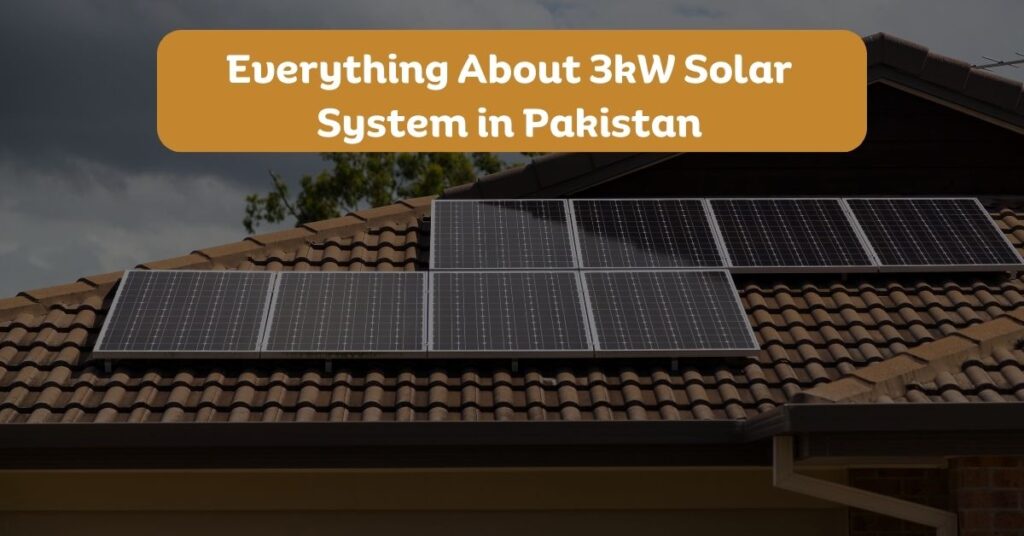6kW solar systems are perfect for homes with higher-than-average energy needs—or offices with average energy usage.
If you have decided to turn to solar power and are about to finalize a 6kW solar system as your preferred system, you may want to ask: how much power does a 6kw solar system produce in Pakistan? Understanding this is important for you in making an informed decision. Without knowing how much you can generate with your system, you can risk installing an undersized—or oversized—system.
To be fair, 6kW solar systems can meet the energy needs of those whose monthly electricity consumption lies between 600 and 800 units.
But the actual power produced varies based on many factors. That’s what this article is about.
In the following lines, we will explore the following aspects of a 6kW solar system:
- How to determine the energy output of a 6kW solar system?
- How much power does a 6kW solar system produce in Pakistan?
- Factors that influence the production capacity of a 6kW solar system.
- The electricity production of a 6kW solar system in various cities of Pakistan, such as Islamabad, Karachi, Peshawar, Quetta, Lahore, and more.
- Tips to optimize the energy generation of a 6kW solar system.
Let’s begin by discussing the factors that should be considered when calculating the energy production of 6kW solar systems—or for that matter, energy produced by any system.
Factors Influencing Solar Power Production of 6kW Solar Systems
The power output of 6kW solar systems can vary due to different factors. Even systems with similar specifications may generate varying amounts of power in different locations. Similarly, systems with components from different brands may produce different power outputs in the same location.
These variations are due to certain factors, such as:
- Solar irradiation in your area
- Efficiency of solar panels
- Panel orientation and tilt angle
- Shading and obstructions
- Dust and debris
Peak Sun Hours in Your Area
Peak sun hours, or solar irradiation, refers to the kind of sunlight that is most suitable for solar energy generation. In Pakistan, the average solar irradiation ranges from 4 to 7 kWh/m2/day, which is sufficient for generating electricity. In simpler terms, this means having 4 to 7 peak sun hours. However, the availability of sunlight can vary depending on the season and location within Pakistan.
To understand solar irradiance in Pakistan well, you can refer to our comprehensive guide on peak sun hours in Pakistan. You can also see the estimated number of peak sun hours for your area in the map given in the article.
Solar Panel Efficiency
The efficiency of solar panels is another factor that greatly affects the power production of solar systems. There are many types of solar panels available in Pakistan, from affordable to expensive. Of course, the efficiency range of these panels varies from manufacturer to manufacturer. Generally, the average efficiency of solar panels is approximately 18%, although newer panels offer around 20% efficiency. I am talking about tier-1 solar panels here.
When calculating power output, an efficiency factor of 0.8 is generally considered—we will utilize this in the formula for solar power production in the upcoming sections of this article.
Tilt Angle and Orientation of Solar Panels
The orientation and elevation angle of solar panels is another determinant that impacts the power production of solar systems, including 6kW solar systems. Elevation angle, or tilt angle, refers to the angle by which we raise panels from the roof surface. Orientation, on the other hand, means the direction in which panels have to face the sun.
In Pakistan, the ideal orientation for solar panels is south-facing, at 180 degrees. Additionally, the tilt angle should match the latitude of the installation location, which ranges from 23 to 37 in Pakistan. For instance, a recommended tilt angle in Islamabad is 33 degrees, although 30 degrees can also yield optimal system performance.
Still want more guidance? Read our guide to calculating the direction and angle of solar panels in Pakistan. In this guide, we have talked more about how to optimize your system’s performance for different seasons and times of the day, simply by choosing a different tilt and orientation angle.
Shading and Obstructions
Now shading and obstructions. Shading from nearby structures, trees, or other obstructions can diminish the power output of solar panels. Installing the panels in areas with minimal shading to maximize energy production is noteworthy.
If shading is unavoidable, take measures to minimize its impact on the system’s performance. For instance, if available, you could choose micro-inverters that would minimize the effect of shading on one panel. Read more on different types of inverters and how they can help your system perform at its best. Sadly, however, I have never come across micro inverters in the Pakistan, so you would have to remove the sources of shading.
Dust and Debris on Your Panels
With time, panels can gather dust, debris, or bird droppings, which can reduce their sunlight absorption. According to a research, if there is dust or bird droppings accumulated on your panels for an year, it will decrease performance by 7%. Do inspect your solar panels after some time and clean them if you think the performance is not up to the mark.

Now that we have discussed the factors, let’s evaluate the power production potential of a 6kW solar system.
A solar system for everyone.
We’re customer-centric; we will find you a solution within your budget. Whatever your project size, you can always save with Ecospark Solar.
How Much Power Does a 6kW Solar System Produce in Pakistan?
On average, a 6kW solar system in Pakistan can generate between 20 and 26 kWh of electricity per day. This translates to approximately 600 to 780 units per month.
That shows that a 6kW solar system is suitable for powering medium-sized homes or businesses that consume around 600 to 700 kWh of electricity monthly. This capacity allows for running appliances like refrigerators and air conditioners.
If you want to know how did we calculate this, proceed below.
To calculate the energy generated by one solar panel, the following formula is employed:
| Daily production of a solar panel = Solar panel capacity x Peak sun hours x Efficiency factor |
We are doing it for a 6kW solar system. Let’s keep the peak sun hours as 5 and an efficiency factor of 0.8.
| Daily Production of 6kW System = 6,000 watts x 5 x 0.8 = 24 kWh (units) |
Actual power produced by your 6kW solar system may vary depending on factors such as the installation location, weather conditions, and system efficiency.
For instance, in areas that receive 6 sun hours, the power produced per day would be: 28.8 kWh (units)
To determine the monthly production, simply multiply the daily generation capacity by 30.
| Monthly Production of 6kW System = Daily Production x 30 = 24 x 30 = 720 kWh (units) |
The graph below shows the daily generation of a 5.8kW solar system we installed in Islamabad a couple of months ago. On most days, the number of units generated are above 25 units – on some days, even more than 30kWh. On cloudy days, the productions is low, as is the case on August 5 where the daily units generated are roughly 17.

Power Generation of a 6kW System in Different Pakistani Cities
The power generation potential of a 6kW solar system may vary slightly across different cities in Pakistan due to variations in solar irradiation levels.
Here is an overview of power production estimates in some major cities:
How much power does a 6kW system produce in Islamabad?
Islamabad/Rawalpindi receives an average of 5.5 kWh/m2/day of solar irradiation, equivalent to 5.5 peak sun hours per day. Thus, a 6kW solar system in Islamabad/Rawalpindi can generate an average of 24 kWh of electricity per day or approximately 720 units per month. It’s quite better, isn’t it?
How much power does a 6kW system produce in Karachi?
In Karachi, a 6kW solar system can generate an average of 19-22 kWh of electricity per day. Pet month, it becomes 570 to 660 monthly units. Karachi receives an average of 5.2 kWh/m2/day of solar irradiation, comparable to the national average of Pakistan.
How much power does a 6kW system produce in Lahore?
6kW solar systems in Lahore can produce an average of 24 kWh of electricity per day, similar to what a 6kW solar system does in Islamabad. Lahore receives an average solar irradiation of 5.4 kWh/m2/day, contributing to its favorable solar conditions.
How much power does a 6kW system produce in Peshawar?
A 6kW solar system in Peshawar can generate an average of 22-24 kWh of electricity per day. Peshawar receives an average solar irradiation of 5.3 kWh/m2/day—which is considered ideal for installing a solar system.
How much power does a 6kW system produce in Quetta?
In Quetta, a 6kW solar system can produce an average of 18-22 kWh of electricity per day. Quetta receives an average solar irradiation of 5.1 kWh/m2/day. During summer, this figure could even surpass the power generation potential of Islamabad.
Please note that these figures serve as estimates, and actual power generation may vary based on specific factors and seasonal variations in sunlight availability.
| You May Like to Read: How to Calculate Solar Payback Period in Pakistan? A Step-By-Step Guide (2023) |
What Can You Run With a 6kW Solar System?
A 6kW solar system can power a wide range of appliances. For example, it can support 5 fans, 10 lights, 1 1.5-ton air conditioner, 1 microwave, 1 iron, 1 refrigerator, 2 LED TVs, 1 washing machine, 1 PC, etc. If you have two air conditioners, a 6kW solar system can also cater to that—you just have to ensure that the load doesn’t become too unbearable.
The capacity to run these appliances depends on the solar panel’s efficiency, sunlight availability in the area, and the appliances’ usage patterns.
How to Maximize the Power Output of Your 6kW Solar System?
To optimize the power output of your 6kW solar system, consider the following measures:
- Select high-quality solar panels with higher efficiency ratings. Avoid substandard panels or inverters, as investing in quality is crucial.
- Ensure proper panel orientation and tilt angle. Professional installers can handle this task effectively.
- Regularly clean and maintain the panels to remove dust or debris.
- Monitor system performance to identify any issues or inefficiencies. Immediately contact your solar installer if there comes an issue—faulty equipment can affect the performance of the whole system.
- Choose an appropriate installation location to minimize shading.
That’s it!
How Much Power Does a 6kW Solar System Produce in Pakistan? Conclusion
A 6kW solar system can generate 600 to 800 units of electricity per month, a viable solution for medium-sized homes and businesses in Pakistan. It provides ample electricity to meet the needs of 3-4 bedroom households and businesses and can power essential appliances. Moreover, it is cost-effective to reduce electricity bills, enhance energy independence, and contribute to environmental preservation.



